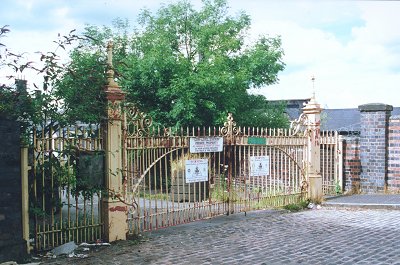|
Listing: 1853-4; enlarged 1869; altered 1899 and 1993-4. Station
building designed by John Fowler. For the Worcester, Oxford and Wolverhampton
Railway, the Birmingham, Wolverhampton and Dudley Railway and the Shrewsbury and
Birmingham Railway. [Original glazed roof over platforms] replaced after 1930 by
platform verandas on cast-iron columns.
Local listing: Gates and Gatepiers to Low Level Station.
Cast iron gates and gatepiers relocated to present site from former Electric
Construction Company, Bushbury, in 1987. Late 19th century.
 |
The gates from the ECC works. They did not quite fit
the entrance and the blue brick wall to the left was built to
make the entrance narrower. My guess is that the gates
were moved here as part of the transport museum proposal, which
failed. |
Comment: The historical importance of the Low Level Station needs a
long article by itself. A good idea of its history can be found
here. The architectural importance of the building speaks for itself and its
interest is much enhanced by its being a rare, if not unique, example, of a very
large classical building's being executed in blue brick. Its importance to the
economic and social history of the town is also self-evident.
The photos below are by Bev Parker, showing an earlier state of decay, before
the bushes started to grow.
And this photo was taken from the other end of the station
in August 2001.

After the station was closed to passengers in 1972 it
remained in use as a goods station but, when even that traffic ceased,
the building was in danger. There have been many suggestions for its
re-use. The first was for converting the whole site into a cinema
complex. The commercial viability of that project was knocked on the
head by the creation of a multi-screen cinema not far away at Bentley.
The developers were then left with a blue elephant on their hands.
The then borough council declared that they would use it as a transport
museum. That proposal staggered around and then fell flat on its
face. Whether it ever was a viable proposition is open to doubt; that it
was badly organised is beyond doubt. The only visible outcome seems to
be the ECC gates and piers being moved to this site.
After further years of delay a company called Next
Generation Clubs, (chiefly notable for being owned by David Lloyd, who
was once a leading British tennis player) came up with the proposal for
tennis courts, indoor and out, squash courts, swimming pools, cafe,
restaurant and hotel. including a transport museum and, more
recently, a cinema and entertainment complex. Apart from getting
planning permission amidst much fanfare, they did nothing. Now
(2003) they have managed to pass on the site to a joint venture
partnership between Oswin Developments and Helical Retail. They
announced a scheme to use the site for a casino, a cinema, a bingo hall,
pubs, restaurants and "up market apartments".
Although much of the site has been redeveloped in the
early years of the 21st century, the station building itself remained
empty. It is now occupied again (early 2013) and hopefully its future is
secured.

This sign is at the pub at Codsall Station - an example of a
successful re-use of old station buildings. There is another identical
sign at the Severn Valley Railway's station at Kidderminster - a wonderful
example of keeping old station buildings in their original use.

|